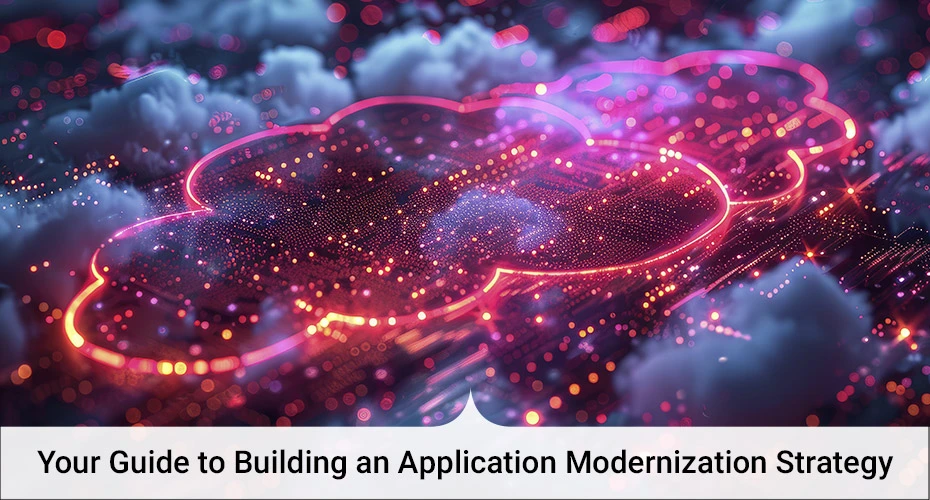May 28, 2024 - by Synoptek
Organizations that have successfully embarked on their digital transformation journey sooner or later realize the need to modernize their legacy applications to drive the intended results from their transformation efforts. Application modernization is not just necessary to improve the efficiency and security of their existing IT landscape; it is also critical to respond to new requirements with agility. Read on to learn what a good application modernization strategy entails, how to build one, potential challenges, and how to overcome them.

The Benefits of an Application Modernization Strategy
Despite the digital era that we currently live in, many organizations today continue to struggle to get the full value of their legacy, on-premises enterprise systems. Establishing an application modernization strategy is a great way to make applications agile and elastic while maximizing their capabilities. You can quickly achieve your transformative IT goals and business outcomes by considering application modernization as an integral part of the larger digital transformation strategy. Listed below are some compelling benefits of an application modernization strategy:
- Improve the capabilities and performance of legacy applications and enhance business agility and speed.
- Enhance application integration capabilities so they can seamlessly work in cohesion with other systems in the IT ecosystem.
- Boost the stability and efficiency of the application landscape while minimizing maintenance time, effort, and cost.
- Improve user experience through UI/UX enhancement, boosting workforce productivity and efficiency.
- Enhance the security of the application landscape through the implementation of necessary encryption and access control mechanisms.
Steps for Building a Strong Application Modernization Strategy
Legacy systems, although integral to the functioning of any business, are not prepared for the pace and scale of digital change. Not only are they incapable of meeting the demands of today, but they also lack the security and integration capabilities that the modern world demands. This makes building a strong application modernization strategy critical to improving systems’ underlying functionality and performance, enhancing their integration capabilities, and boosting the user experience. Here are some tips for building a strong application modernization strategy:
1. Define Your Modernization Goals
Many companies approach modernization without realizing that an application modernization strategy should be established based on the business’s KPIs and must focus on the flaws of existing IT systems. Understanding what your company lacks will keep your strategy healthy and keep you ahead of your competitors.
2. Conduct a Detailed Gap Analysis
Conducting an in-depth assessment of your legacy application portfolio is key to determining the best course of action. A detailed gap analysis can help you identify your weak spots, including what applications need to be modernized first, what expertise you need, and what challenges you are likely to face. Such assessments will also help you choose the right modernization approach (re-architecting/ re-coding/ re-platforming/ retiring) and technology (cloud/ microservices/ containerization).
3. Ensure Leadership Support
Since application modernization is a complex and costly enterprise-wide strategy, make sure to have the support and guidance of your leadership team. Their support assures you of the budget required for the modernization effort and helps you overcome challenges and bottlenecks. Since your modernization involves multiple technical aspects, business operations, and agile transformation, it requires the participation of skilled professionals. Ensuring leadership support means evaluating your available resources and planning.
4. Evaluate Your Risk Tolerance
Another critical factor to remember while building your application modernization strategy is your organization’s risk tolerance capability. Identifying your most critical applications and gauging the impact of re-coding, re-factoring, or re-platforming on availability and security is critical to minimize performance and user experience issues.
5. Up Your Backup Game
Modernizing rigid and proprietary applications can mean long periods of downtime. Therefore, to ensure your applications continue to serve the business, back up all necessary data and logs in the cloud to ensure application functionality and user experience are unscathed.
6. Ensure Effective Change Management and User Adoption
Application modernization initiatives often significantly change existing processes, workflows, and user interfaces. To ensure a smooth transition and maximize the benefits of modernized applications, it’s crucial to prioritize change management and user adoption strategies. Ensure to clearly communicate the rationale, benefits, and expected changes to all stakeholders, including end-users. Developing a comprehensive training program will equip users with the necessary knowledge to use the updated applications effectively.
7. Monitor and Optimize
A single wrong move can lead to extreme frustration; therefore, once you have modernized your applications, make it a point to monitor their performance constantly. This will help uncover insights into what’s working and what’s not working for your business while providing opportunities to tweak your approach and set a clear path to modernization success.
Common Application Modernization Challenges
Although an indispensable aspect of digital transformation, application modernization is also prone to several challenges. Let’s look at common application modernization challenges:
1. Lack of Expertise
One of the biggest roadblocks to successful application modernization is the lack of the right expertise. Organizations often do not have the skills or resources they need to modernize their application stack. Partnering with a qualified and competent expert is an excellent way to 1) get the right guidance, 2) carry out successful modernization, and 3) ensure modernization efforts reap the intended benefits.
2. Lack of Appropriate Budget
Another hurdle in the application modernization journey is the lack of the required budget for enterprise-wide modernization. Since legacy systems are too complicated and demand knowledge of proprietary technologies for successful modernization, opting for a Managed Services partner can eliminate upfront expenditure while spreading costs over a period of time.
3. Lack of a Robust Security Architecture
Organizations often face challenges ensuring data security and regulatory compliance during application modernization initiatives. Modernized applications may need to handle sensitive data, which requires adhering to strict regulations like GDPR and HIPAA. Failure to implement adequate security measures and comply with these regulations can have significant legal and financial consequences. Partnering with an expert can help organizations navigate these challenges throughout the modernization process.
Build a Solid Application Modernization Strategy Today
Organizations that begin their digital transformation journey often focus only on implementing innovative technology solutions to keep up with market demands and customer expectations. However, they fail to realize that no transformation can be successful without a deep focus on application modernization. Building a strong application modernization strategy is critical to enhancing applications’ availability, performance, and security while making them relevant in today’s digital age. Are you ready to modernize your legacy applications? Contact us today!


